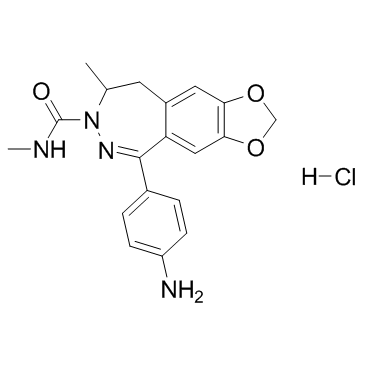GYKI53655 hydrochloride
Modify Date: 2025-08-25 18:36:19

GYKI53655 hydrochloride structure
|
Common Name | GYKI53655 hydrochloride | ||
|---|---|---|---|---|
| CAS Number | 143692-48-2 | Molecular Weight | 388.84800 | |
| Density | N/A | Boiling Point | 563.6ºC at 760 mmHg | |
| Molecular Formula | C19H21ClN4O3 | Melting Point | N/A | |
| MSDS | Chinese USA | Flash Point | 294.7ºC | |
Use of GYKI53655 hydrochlorideGYKI53655 hydrochloride is an α-amino-3-hydroxy-5-methylisoxazole-4-propionic acid (AMPA) antagonist. |
| Name | 5-(4-aminophenyl)-N,8-dimethyl-8,9-dihydro-[1,3]dioxolo[4,5-h][2,3]benzodiazepine-7-carboxamide,hydrochloride |
|---|---|
| Synonym | More Synonyms |
| Description | GYKI53655 hydrochloride is an α-amino-3-hydroxy-5-methylisoxazole-4-propionic acid (AMPA) antagonist. |
|---|---|
| Related Catalog | |
| Target |
AMPA[1] |
| In Vitro | GYKI53655 hydrochloride (LY300168) inhibits α-amino-3-hydroxy-5-methylisoxazole-4-propionic acid (AMPA) (10 μM)-induced responses with IC50 value of 5.9±0.1 μM. GYKI53655 hydrochloride inhibits AMPA (10 μM) responses inrecombinant G1uR4 expressing HEK293 cells with IC50 value of 4.6±0.4 μM. Using 3 μM cyclothiazide the inhibition produced by GYKI53655 hydrochloride is 79±2% (n=4 cells). GYKI53655 hydrochloride produces only small inhibitions of kainate-induced currents at 30 μM and inhibits kainate-induced currents at a concentration of 100 μM by 12±2 (n=4) and 18±4 (n=4), respectively. GYKI53655 hydrochloride inhibits AMPA receptor-mediated responses in cerebella Purkinje neurons with an IC50 value of 1.5±0.1 μM[1]. |
| In Vivo | GYKI53655 hydrochloride (4 mg/kg) is found to have a short-lasting depressant effect on neuronal responses to iontophoreticα-amino-3-hydroxy-5-methylisoxazole-4-propionic acid (AMPA), with a half-recovery time of approximately 7 min. GYKI53655 hydrochloride (4 and 8 mg/kg) substantially depresses or completely abolishes AMPA responses. Results demonstrate the dose-dependence of GYKI53655 hydrochloride (2 to 8 mg/kg) in depressing responses to AMPA. At the highest doses tested, GYKI53655 hydrochloride reduces AMPA responses to a comparable degree[2]. Tonic fit and death are completely prevented by GYKI53655 hydrochloride at dose over 5.0 mg/kg. The ED50 value of GYKI53655 hydrochloride is 2.2 mg/kg i.p. The maximal effects of GYKI53655 hydrochloride lasts 3 h then the exit inhibition effect of GYKI53655 hydrochloride falls to 20% 1 h later[3]. |
| Cell Assay | Whole-cell voltage clamp recordings are made from single cells with use of the tight seal whole cell configuration of the patch-clamp technique. Experiments are performed at room temperature (20 to 22°C) and recorded on an amplifier. GYKI53655 hydrochloride application is via a series of perfusion lines to a multi-barrelled applicator and exchange of solutions under the present recording conditions is approximately 100 msec. For the acutely isolated cerebella Purkinje neurons, GYKI53655 hydrochloride application is by bath perfusion and occurs within approximately 15 sec. Curve fitting to data points is based upon the equationy=100(Dn/(Dn+IC50n)), where the slope of the line n is fixed to a value of 1 and D is the antagonist concentration. Statistical significance is determined by one-way ANOVA followed by Student- Newman-Keulstest[1]. |
| Animal Admin | Experiments are performed on 27 male Wistar rats (260 to 350 g). Briefly, rats are anaesthetized with halothane in O2 and tracheal, carotid and jugular cannulae are inserted. The lumbo-thoracic spinal cord is exposed and cut at T9-T11 and the animal is prepared for extracellular recordings of single dorsal horn neurone action potentials. Anaesthesia after surgery is maintained with α-chloralose. Jugular cannulae are inserted. GYKI53655 hydrochloride is administered intravenously. The effect of GYKI53655 hydrochloride is expressed quantitatively as percentages of control excitatory amino acids (EAA) responses, where control is taken as the mean of the last 3 pre-drug counts; mean values±s.e.mean are indicated. No corrections for spontaneous activity are made[2]. |
| References |
| Boiling Point | 563.6ºC at 760 mmHg |
|---|---|
| Molecular Formula | C19H21ClN4O3 |
| Molecular Weight | 388.84800 |
| Flash Point | 294.7ºC |
| Exact Mass | 388.13000 |
| PSA | 92.67000 |
| LogP | 3.29700 |
| Vapour Pressure | 5.11E-13mmHg at 25°C |
| Storage condition | 2-8℃ |
| Ivermectin B1a-d2 |
| 5-(4-aminophenyl)-N,8-dimethyl-8,9-dihydro-7H-[1,3]dioxolo[4,5-h][2,3]benzodiazepine-7-carboxamide hydrochloride (1:1) |
| 7H-1,3-Dioxolo(4,5-h)(2,3)benzodiazepine-7-carboxamide,8,9-dihydro-5-(4-aminophenyl)-N,8-dimethyl-,monohydrochloride |
| GYKI-53655 hydrate |
| GYKI53655 hydrochloride |